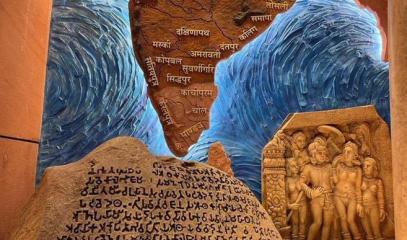'Greater India' map casts a shadow over the country’s new parliament building
Modi’s new, post-colonial parliament building is proving controversial among India’s neighbours for a mural showing a map of the Ashoka Empire, whose boundaries also include Nepal, Pakistan, Bangladesh, Afghanistan, Myanmar, Sri Lanka, and Maldives. Indian officials dismiss complaints saying that the map is about past history, not contemporary politics. In Nepal the controversy has raised fears about Hindu nationalist expansionism.
New Delhi (AsiaNews) – The opening of India’s new parliament building to replace the British Raj-era structure was supposed to be the first step in Narendra Modi's celebration of post-colonial India.
However, a controversial mural showing a map of ancient India was unveiled during the inauguration on 28 May, sparking a row with India’s neighbours, alarmed by its reference to the idea of Greater or Undivided India (अखण्ड भारत or Akhand Bharat), dreamt by today’s Hindu nationalists.
The new Indian Parliament is the centrepiece of a US$ 2.4 billion project to give the capital’s British colonial-era central buildings a more distinctive Indian identity
Prime Minister Modi’s decision to personally preside over the inauguration had already sparked opposition from the country’s 20 or so opposition parties, who boycotted the ceremony on the grounds that India’s president, not the prime minister, should have inaugurated the new site.
No sooner was this controversy over that another was sparked by the mural of the ancient Empire of Ashoka (3rd century BC), which depicts an undivided India that includes modern-day Afghanistan, Pakistan, Maldives, Sri Lanka, Myanmar, Bangladesh, Nepal, and India.
The harshest reaction came from Nepal, a country with a delicate relationship with its southern neighbour. What irritated Nepalis in particular was the location of Lumbini, the birthplace of Buddha, one of Nepal’s foremost cultural centres.
“The controversial mural of ‘Akhand Bharat’ in the recently inaugurated new Parliament building of India may stoke unnecessary and harmful diplomatic row in the neighbourhood, including Nepal,” said former Nepali Prime Minister Baburam Bhattarai.
In fact, “It has the potential of further aggravating the trust deficit already vitiating the bilateral relations between most of the immediate neighbours of India,” he added.
For his part, Kathmandu Mayor Balendra Shah responded by putting a new ‘Greater Nepal’ map in his office, which includes large areas of India claimed by Nepal, namely the strip of land connecting north-eastern states to the rest of the country.
For his part, current Nepali Prime Minister of Nepal Prachanda tried to appease tensions, telling the Nepali parliament that he raised the issue with Indian officials who said that the map had cultural relevance with no political overtones.
The governments of Pakistan and Bangladesh too criticised the map.
“We urge that India should stay away from expansionist ideology and come forward to settle disputes with its neighbouring countries in a peaceful manner," said Pakistani Foreign Ministry spokeswoman Mumtaz Zahra Baloch.
In Bangladesh, the government said that, “There is no reason to express doubts about” the explanations India offered after protests broke out in Nepal; however, considering concerns expressed in Bangladesh itself, it instructed its “mission in Delhi to speak to the Indian Ministry of External Affairs to find out what their official explanation is”.
INDIAN MANDALA IS THE ASIANEWS NEWSLETTER DEDICATED TO INDIA. WOULD YOU LIKE TO RECEIVE IT EVERY FRIDAY IN YOUR E-MAIL? TO SUBSCRIBE, CLICK HERE.








.png)










